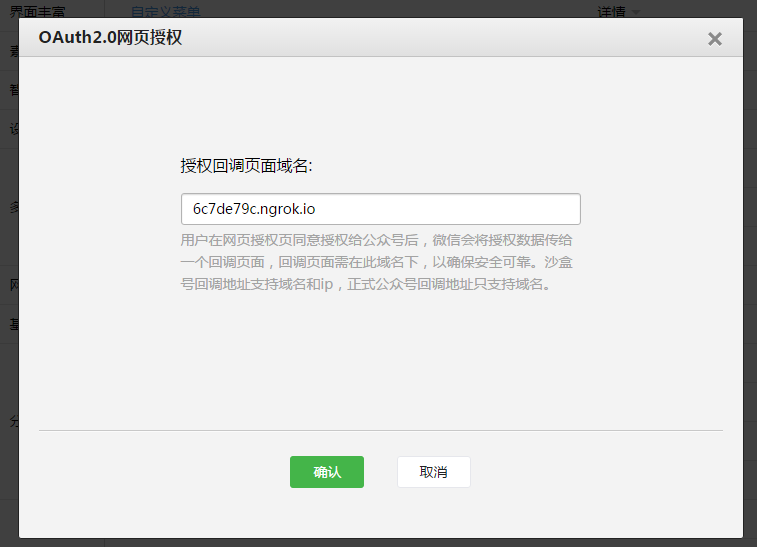第三方网站微信登录实现
好记性不如烂笔头!且 coding 且记下^^
前两个星期在公司中的项目加上了微信登录、绑定的功能,在这里做个记录!
一、开发前知识
1、微信开放平台与微信公众平台的区别
1.1 微信公众平台:
① 地址: https://mp.weixin.qq.com/cgi-bin/loginpage?t=wxm2-login&lang=zh_CN
② 微信公众平台面向的是普通的用户,比如自媒体和媒体,企业官方微信公众账号运营人员使用,当然你所在的团队或者公司有实力去开发一些内容,也可以调用公众平台里面的接口,比如自定义菜单,自动回复,查询功能。
1.2 微信开放平台:
① 地址: https://open.weixin.qq.com/
微信开放平台:面向的是开发者和第三方独立软件开发商。开放平台的文档似乎包含了微信开放平台文档里面的接口。
2、微信公众平台目前只支持80端口,且项目上传到服务器上面不容易debug啊?
解决方法: ngrok 工具,可以根据本地项目映射成外网可以访问的地址、端口,默认映射为80端口。
官网: https://dashboard.ngrok.com
存在问题: 每次重启,域名会变化,都需要项目中、微信公众平台配置,付费可以固定域名。。。
使用方法: ① 注册后获得一个授权码,下载 ngrok
② 》CMD 进入 ngrok 目录
》ngrok authtoken 授权码
》ngrok http 8080
③看到这个页面,ngrok就为你分配了临时访问通道成功了^^

二、配置
(每个微信号可以申请成为开发者测试账号进行微信功能开发的。)
1、在公众平台中进行配置:
地址: http://mp.weixin.qq.com/debug/cgi-bin/sandboxinfo?action=showinfo&t=sandbox/index
①:配 置 “接口配置信息” (Token 在项目中我是配置为"handsomeKing",没错,我就是King ^^)


好了,可以愉快的 coding 了!!!
三、可以开发啦
1、上面的 “接口配置信息” 配置得 wechat/ownerCheck 方法是验证 这个url 为我自己的,handsomeKing 就是这个方法中的一个参数。微信这个小朋友会用Get方法带上4个参数给我服务器: signature(签名)、timestamp(时间戳)、nonce(随机数)、echostr(随机字符串),再加上咱们项目中自己配置的 token ,通过检验signature对请求进行校验,若校验成功则原样返回echostr,表示接入成功,否则接入失败:(talk is cheap, show me the code *&)
/** * 微信消息接收和token验证 * @param model * @param request * @param response * @throws IOException */ @RequestMapping("/ownerCheck") public void ownerCheck(Model model, HttpServletRequest request,HttpServletResponse response) throws IOException { System.out.println(111); boolean isGet = request.getMethod().toLowerCase().equals("get"); PrintWriter print; if (isGet) { // 微信加密签名 String signature = request.getParameter("signature"); // 时间戳 String timestamp = request.getParameter("timestamp"); // 随机数 String nonce = request.getParameter("nonce"); // 随机字符串 String echostr = request.getParameter("echostr"); // 通过检验signature对请求进行校验,若校验成功则原样返回echostr,表示接入成功,否则接入失败 if (signature != null && CheckoutUtil.checkSignature(signature, timestamp, nonce)) { try { print = response.getWriter(); print.write(echostr); print.flush(); } catch (IOException e) { e.printStackTrace(); } } } }
import java.security.MessageDigest; import java.security.NoSuchAlgorithmException; public class CheckoutUtil { // 与接口配置信息中的Token要一致 private static String token = "handsomeKing"; /** * 验证签名 * * @param signature * @param timestamp * @param nonce * @return */ public static boolean checkSignature(String signature, String timestamp, String nonce) { String[] arr = new String[] { token, timestamp, nonce }; // 将token、timestamp、nonce三个参数进行字典序排序 // Arrays.sort(arr); sort(arr); StringBuilder content = new StringBuilder(); for (int i = 0; i < arr.length; i++) { content.append(arr[i]); } MessageDigest md = null; String tmpStr = null; try { md = MessageDigest.getInstance("SHA-1"); // 将三个参数字符串拼接成一个字符串进行sha1加密 byte[] digest = md.digest(content.toString().getBytes()); tmpStr = byteToStr(digest); } catch (NoSuchAlgorithmException e) { e.printStackTrace(); } content = null; // 将sha1加密后的字符串可与signature对比,标识该请求来源于微信 return tmpStr != null ? tmpStr.equals(signature.toUpperCase()) : false; } /** * 将字节数组转换为十六进制字符串 * * @param byteArray * @return */ private static String byteToStr(byte[] byteArray) { String strDigest = ""; for (int i = 0; i < byteArray.length; i++) { strDigest += byteToHexStr(byteArray[i]); } return strDigest; } /** * 将字节转换为十六进制字符串 * * @param mByte * @return */ private static String byteToHexStr(byte mByte) { char[] Digit = { '0', '1', '2', '3', '4', '5', '6', '7', '8', '9', 'A', 'B', 'C', 'D', 'E', 'F' }; char[] tempArr = new char[2]; tempArr[0] = Digit[(mByte >>> 4) & 0X0F]; tempArr[1] = Digit[mByte & 0X0F]; String s = new String(tempArr); return s; } public static void sort(String a[]) { for (int i = 0; i < a.length - 1; i++) { for (int j = i + 1; j < a.length; j++) { if (a[j].compareTo(a[i]) < 0) { String temp = a[i]; a[i] = a[j]; a[j] = temp; } } } } }
2、用户用户同意授权,获取微信服务器传过来的俩参数: code、state。其中:
APPID: 微信开发者测试账号
REDIRECT_URI: 同意授权后跳转的 URL
/** * 第一步:用户同意授权,获取code(引导关注者打开如下页面:) * 获取 code、state */ public static String getStartURLToGetCode() { String takenUrl = "https://open.weixin.qq.com/connect/oauth2/authorize?appid=APPID&redirect_uri=REDIRECT_URI&response_type=code&scope=SCOPE&state=STATE#wechat_redirect"; takenUrl= takenUrl.replace("APPID", Param.APPID); takenUrl= takenUrl.replace("REDIRECT_URI", URL.encode(Param.REDIRECT_URI)); //FIXME : snsapi_userinfo takenUrl= takenUrl.replace("SCOPE", "snsapi_userinfo"); System.out.println(takenUrl); return takenUrl; }
3、获取微信用户的 access_token、openid
APPID: 微信开发者测试账号
secret: 微信开发者测试账号密码
code: 上一步的 code
/** * 获取access_token、openid * 第二步:通过code获取access_token * @param code url = "https://api.weixin.qq.com/sns/oauth2/access_token * ?appid=APPID * &secret=SECRET * &code=CODE * &grant_type=authorization_code" * */ public static OAuthInfo getAccess_token(String code){ String authUrl = "https://api.weixin.qq.com/sns/oauth2/access_token?appid=APPID&secret=SECRET&code=CODE&grant_type=authorization_code "; authUrl= authUrl.replace("APPID", Param.APPID); authUrl = authUrl.replace("SECRET", Param.SECRET); authUrl = authUrl.replace("CODE", code); String jsonString = HTTPRequestUtil.sendPost(authUrl,""); System.out.println("jsonString: " + jsonString); OAuthInfo auth = null; try { auth = (OAuthInfo) JacksonUtil.parseJSONToObject(OAuthInfo.class, jsonString); } catch (Exception e) { e.printStackTrace(); } return auth; }
4、在数据库中查询 openid
我是定义了一个对象 OauthInfo,包括 openid(用户的标识)属性。。。
查询时库中存在就直接登录啦,不存在就先去登录页,将登录账号同 openid 绑定。
/** * 微信引导页进入的方法 * @return */ @RequestMapping("/loginByWeiXin") public String loginByWeiXin(HttpServletRequest request, Map<String, Object> map) { // 微信接口自带 2 个参数 String code = request.getParameter("code"); String state = request.getParameter("state"); System.out.println("code = " + code + ", state = " + state); if(code != null && !"".equals(code)) { // 授权成功, 微信获取用户openID OAuthInfo authInfo = WeiXinUtil.getAccess_token(code); String openid = authInfo.getOpenid(); String access_token = authInfo.getAccess_token(); if(access_token == null) { // Code 使用过 异常 System.out.println("Code 使用过 异常....."); return "redirect:" + WeiXinUtil.getStartURLToGetCode(); } // 数据库中查询微信号是否绑定平台账号 SysUser sysUser = weiXinService.getUserByWeiXinID(openid); if(sysUser == null) { String randomStr = StringUtil.getRandomString(50); request.getSession().setAttribute(openid, randomStr); // 尚未绑定账号 System.out.println("尚未绑定账号....."); return "redirect:/index.jsp?openid=" + openid + "&state=" + randomStr; } userController.doSomeLoginWorkToHomePage(sysUser.getMcid(), map); // 登录成功 return "homePage"; } // 未授权 return "redirect:" + WeiXinUtil.getStartURLToGetCode(); }
四、踩过的坑
1、access_token 与 普通 access_token。这尼玛是啥关系?
答:access_token: 登录授权会得到一个 access_token, 这个是用于标识登录用户(没有使用次数限制),绑定流程中用的都是 登录 access_token。
普通 access_token: 调用其它微信应用接口时需要带上的 access_token,普通 access_token时效为 2H, 每个应用每天调用次数<= 2000次。(实际开发时必须加以处理。。我采用的是 quartz 调度^^)
2、 uuid、openid。我该绑定uuid?不不不,openid?不不,到底绑哪个?
答:uuid: 微信号绑定后才有的标识,对于任何应用该微信账号的 uuid 均相同。同一个微信账号不同的应用 uuid 相同。
openid: 微信号对于每个应用均有一个不变的 openid,同一个微信账号不同的应用 openid 不同。
五、参考的链接!感谢!!




 浙公网安备 33010602011771号
浙公网安备 33010602011771号